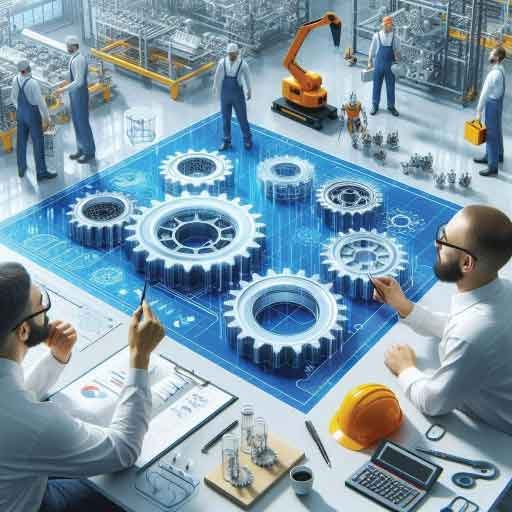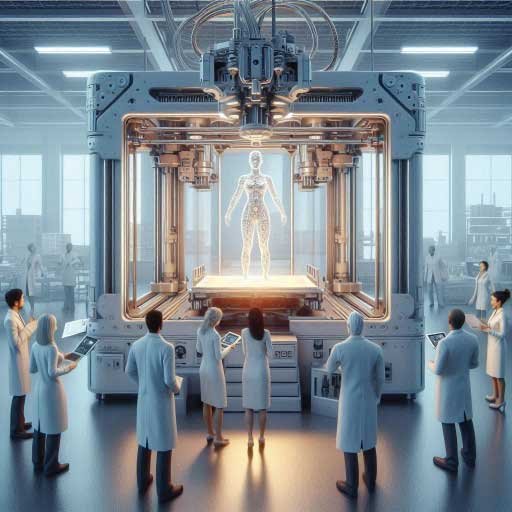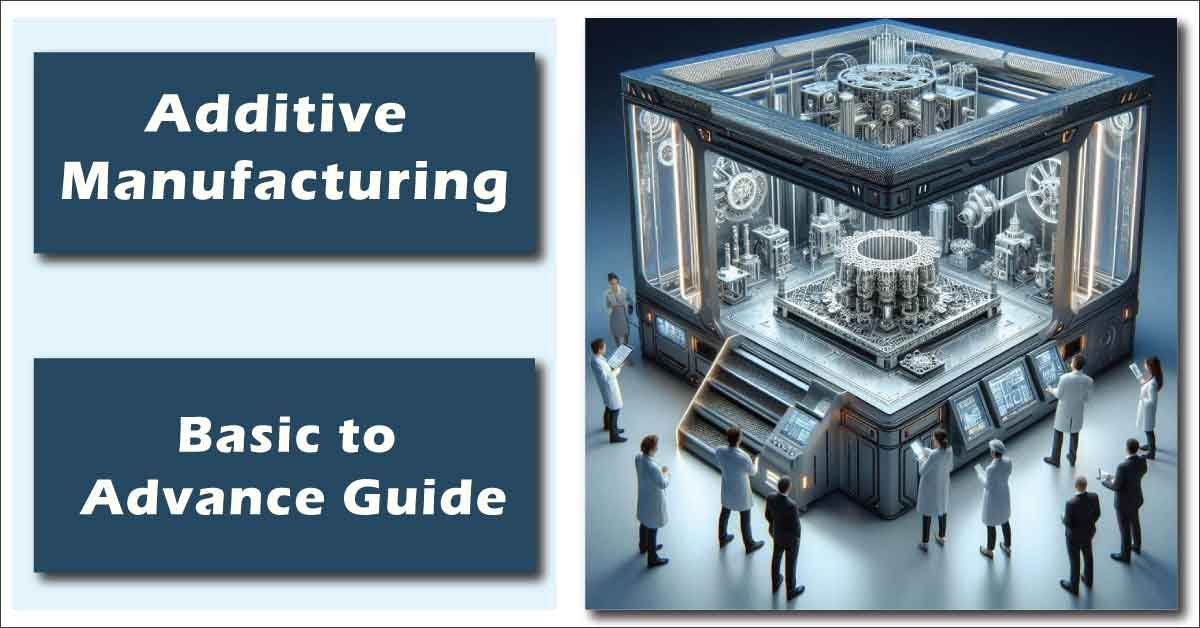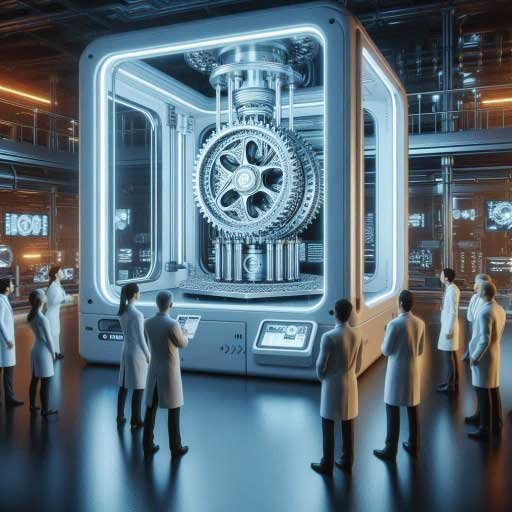Additive Manufacturing (AM), often referred to as 3D printing, has taken the world by storm. It represents a shift from traditional manufacturing processes, offering a dynamic and flexible approach to creating complex objects. This article dives into the meaning, history, types, and the many advantages and challenges associated with additive manufacturing.
Additive Manufacturing Meaning
Additive Manufacturing (AM) is a transformative approach to producing parts and products by building them layer by layer from a digital design. Unlike traditional methods, which rely on subtractive processes (cutting, drilling, etc.), AM adds material progressively to create the final product, allowing for more design flexibility and resource efficiency.
What is Additive Manufacturing?
Additive Manufacturing (AM), also known as 3D printing, is an advanced manufacturing process that creates objects by building them layer upon layer from 3D model data. Unlike traditional manufacturing methods, which often involve subtracting material from a larger block through cutting, drilling, or milling, AM adds material exactly where needed. This precise, controlled process allows for intricate designs that are difficult or impossible to achieve with traditional methods.
Key Features of Additive Manufacturing
AM is highly versatile and can use a variety of materials, including polymers, metals, ceramics, and composites. The process is suitable for both rapid prototyping and full-scale production, making it an essential tool across numerous industries. AM’s ability to create complex geometries, such as lattice structures or internal cavities, allows for lightweight and optimized designs, often resulting in increased performance and reduced material waste.
When Was Additive Manufacturing Invented?
Additive Manufacturing emerged in the 1980s with the invention of the first 3D printing process, Stereolithography (SLA). Invented by Chuck Hull in 1983, SLA uses a laser to cure liquid resin into solid layers, gradually forming a complete object. Hull’s creation marked the beginning of modern AM, and he founded 3D Systems, one of the first companies dedicated to commercializing the technology.
Throughout the 1990s and 2000s, additional AM techniques like Selective Laser Sintering (SLS) and Fused Deposition Modeling (FDM) were developed, expanding the capabilities of AM. Today, AM is a global industry, with applications spanning aerospace, automotive, medical, and consumer goods.
Materials for Additive Manufacturing
One of the significant advantages of AM is its compatibility with a broad spectrum of materials, each tailored to specific needs and applications:
1. Plastics/Polymers:
Widely used for prototyping, especially in consumer products. Materials like ABS, PLA, and nylon are popular for their ease of use and flexibility.
2. Metals:
Essential for producing parts that require high strength and durability, such as aerospace and automotive components. Common metals include aluminum, titanium, and stainless steel.
3. Ceramics:
Used in high-temperature environments like turbine engines, ceramics offer exceptional heat resistance.
4. Composites:
Combine materials to enhance strength, flexibility, or other properties, allowing for innovative design solutions in industries such as defense and sports.
Choosing the right material depends on the application, the desired properties of the final product, and the specific AM process used.
Additive Manufacturing Process
The additive manufacturing (AM) process is a systematic approach that transforms a digital design into a physical object. It generally follows these essential stages:
1. Design Phase
The process begins with the creation of a 3D digital model using Computer-Aided Design (CAD) software. Engineers or designers develop a highly detailed model that serves as the blueprint for the final product. This phase is crucial because it allows for the design of intricate geometries, optimized structures, and highly customized shapes that traditional manufacturing methods would struggle to achieve.
2. Slicing
Once the digital model is complete, it is sliced into thin horizontal layers. These layers serve as instructions for the printer, guiding it on how to build the object one layer at a time. The slicing process is critical for the precision of the final product, as it dictates how each layer will be deposited.
3. Printing
In the printing stage, the additive manufacturing machine begins to deposit material layer by layer according to the sliced model. This step is highly automated, and different printers use various methods to build the object, whether through extrusion, sintering, or curing. The printing speed, resolution, and material choice depend on the specific AM technology being used.
4. Post-Processing
After printing, most objects require post-processing to improve the surface finish, mechanical properties, or appearance. Post-processing steps can include polishing, machining, surface finishing, or heat treatment. This stage ensures the final product meets the desired standards for its intended application, particularly in industries such as aerospace and healthcare where precision and quality are critical.
Related Post:
Unlock the essentials of Manufacturing Processes with everything you need to know about techniques and their applications. Read the complete guide for in-depth insights and valuable knowledge!

Additive Manufacturing Types
Several distinct types of additive manufacturing exist, each suited to different applications and industries. These are some of the most widely used AM processes:
1. Stereolithography (SLA)
SLA uses ultraviolet (UV) light to cure a liquid resin layer by layer, turning it into a solid object. This method is known for producing highly detailed, smooth surfaces and is commonly used for prototyping and creating molds.
2. Selective Laser Sintering (SLS)
SLS uses a high-power laser to fuse powdered materials, such as nylon or metal. It is particularly suited for creating durable, functional parts and is widely used in industries like aerospace and automotive for small-batch production.
3. Fused Deposition Modeling (FDM)
FDM works by melting plastic filament and depositing it layer by layer. It is one of the most common and accessible types of 3D printing, ideal for producing prototypes and low-cost, functional parts in industries such as consumer goods.
4. Direct Metal Laser Sintering (DMLS)
DMLS uses a laser to sinter metal powders together, allowing for the production of high-strength metal parts. It is widely used in industries like aerospace and medical devices for manufacturing components that require excellent mechanical properties.
5. Electron Beam Melting (EBM)
Similar to DMLS, EBM uses an electron beam to melt metal powder. This process is faster and capable of producing parts with better density and strength, making it ideal for high-performance applications in aerospace and defense.
6. Material Jetting
Material Jetting functions similarly to inkjet printing but deposits layers of liquid material (often polymers) that solidify to form the object. This process is known for its high resolution and ability to print multi-material objects with different colors or properties.
Each type of AM has unique features, strengths, and limitations, allowing industries to select the appropriate technology based on specific requirements.
Additive Manufacturing Examples
Additive Manufacturing has been embraced by numerous industries due to its versatility and potential for innovation. Here are some prominent examples of how AM is transforming different sectors:
1. Aerospace
In the aerospace industry, additive manufacturing allows for the production of lightweight, complex parts that traditional methods would struggle to create. For instance, GE Aviation uses AM to manufacture fuel nozzles for jet engines, which are lighter and more efficient than conventionally produced parts. These nozzles are now used in thousands of commercial aircraft around the world.
2. Automotive
In the automotive industry, companies like Ford use AM to quickly prototype car parts, speeding up the design and testing process. The ability to create custom parts for vehicles and test them in real-world conditions without the need for expensive tooling has revolutionized the automotive design process.
3. Healthcare
Additive manufacturing has made a significant impact in the medical field, particularly in custom prosthetics and implants. 3D printing allows for the creation of personalized medical devices that fit the unique anatomy of each patient, improving comfort and effectiveness. Surgeons also use AM to create 3D models of patients’ anatomy to plan complex surgeries more effectively.
4. Consumer Goods
Companies like Nike have adopted AM to rapidly prototype new designs for shoes and other consumer products. In some cases, AM is used to create custom, limited-edition items for consumers, adding a level of personalization and exclusivity that traditional manufacturing cannot provide.
These examples highlight how additive manufacturing is transforming industries by enabling faster production cycles, creating complex designs, and offering unprecedented customization. As the technology continues to evolve, its applications are expected to expand even further across multiple sectors.
Related Post:
Uncover the essentials of Smart Manufacturing and learn how it leverages advanced technologies to enhance efficiency and productivity. Read the full post for a simple and comprehensive explanation!
Carbon Additive Manufacturing
Carbon Additive Manufacturing revolutionized the industry with its Digital Light Synthesis (DLS) technology. DLS uses a unique process where light and oxygen work together to cure photosensitive resin into solid structures. What sets Carbon apart is the speed and precision of this method, allowing for rapid production of high-performance parts with superior mechanical properties compared to traditional methods.
This technology has gained traction across multiple industries. In the automotive sector, manufacturers use Carbon’s DLS to produce lightweight, durable parts for enhanced vehicle performance. The healthcare industry utilizes DLS for creating custom dental aligners and prosthetics, offering tailor-made solutions for individual patients. Similarly, consumer goods companies like Adidas leverage Carbon’s technology for the mass production of custom athletic shoes, allowing for better performance and comfort through individualized design.
Overall, Carbon’s DLS stands out for its ability to provide mass customization, faster production times, and higher-quality products, making it a crucial player in the field of additive manufacturing.

Progress in Additive Manufacturing
The progress in additive manufacturing over the past decade has been nothing short of remarkable. What began as a technology primarily used for rapid prototyping has now evolved into a robust solution for full-scale production. Advances in printing speed, material variety, and post-processing techniques have driven the widespread adoption of AM across industries.
Recent innovations include the ability to print with multiple materials simultaneously, making it possible to integrate different material properties within a single part. Additionally, faster build times have made it more viable for mass production, while improvements in resolution allow for finer details and smoother surface finishes, which are critical in sectors like aerospace and healthcare.
Progress has also been made in the development of new, more durable materials, such as high-strength composites and biocompatible polymers, opening doors to even more applications. With these advancements, AM is no longer limited to niche markets; it is transforming industries by offering more efficient, customizable, and innovative manufacturing solutions.
Related Post:
Dive into Advanced Manufacturing Technology and discover how it’s revolutionizing industries through innovation and efficiency. Read the full post for insights into its transformative impact on modern manufacturing!
Additive Manufacturing Trends
Several emerging trends are shaping the future of additive manufacturing, highlighting its growing influence in the industrial sector:
1. Mass Customization
One of the most exciting trends in AM is the ability to offer mass customization. In industries like healthcare and footwear, manufacturers can now produce products tailored to individual needs. For example, in healthcare, custom prosthetics, dental implants, and even personalized medicine delivery systems are being developed through 3D printing.
2. Sustainability
As companies strive to reduce their environmental footprint, sustainability has become a significant focus. Additive manufacturing is inherently more sustainable than traditional methods, as it minimizes material waste by using only the exact amount of material needed to build each part. This is particularly important in industries like automotive and aerospace, where material costs are high, and environmental regulations are becoming more stringent.
3. Hybrid Manufacturing
The rise of hybrid manufacturing combines the best aspects of additive and traditional manufacturing processes. By using AM to produce complex geometries and integrating traditional methods for finishing and assembly, companies can capitalize on the strengths of both approaches to improve efficiency and performance.
4. AI Integration
Artificial intelligence (AI) is increasingly being used to optimize additive manufacturing workflows. AI can analyze designs and suggest improvements for performance, material efficiency, and print time. In the future, we may see fully autonomous systems where AI designs, prints, and finishes products without human intervention.
These trends indicate a bright future for additive manufacturing, as it continues to integrate with advanced technologies and meets the growing demands for efficiency, customization, and sustainability.
Additive Manufacturing Benefits
The benefits of additive manufacturing (AM) are wide-ranging, offering significant advantages over traditional manufacturing processes:
1. Design Freedom
AM allows for unparalleled design freedom, enabling engineers and designers to create complex shapes and structures that would be impossible to produce using traditional methods. Intricate lattice structures, internal channels, and organic forms can be printed with ease, pushing the boundaries of innovation in sectors such as aerospace, automotive, and medical devices.
2. Reduced Waste
Traditional manufacturing techniques, such as machining or molding, often result in a significant amount of material waste. In contrast, AM is an inherently low-waste process, as material is only added where needed. This not only leads to cost savings but also promotes environmental sustainability by minimizing the use of raw materials.
3. Faster Prototyping
Additive manufacturing speeds up the prototyping process by allowing engineers to iterate designs quickly without the need for expensive molds or tooling. This ability to rapidly prototype and test multiple designs enables faster product development cycles and brings innovations to market sooner.
4. Customization
Customization is one of the most valuable benefits of AM. It allows manufacturers to tailor products to the specific needs of customers, particularly in the healthcare and consumer goods industries. Whether it’s a custom medical implant or personalized footwear, additive manufacturing makes it possible to mass-produce customized products at a lower cost.
These advantages, combined with AM’s flexibility and efficiency, demonstrate why additive manufacturing is becoming an essential part of modern manufacturing strategies.
Related Post:
Additive Manufacturing Advantages
1. Reduced Lead Time:
Additive manufacturing can drastically cut down production time, with parts being created in hours or days compared to the weeks or months required by traditional manufacturing methods. This makes it especially useful for rapid prototyping and meeting urgent production needs.
2. Complex Geometry:
One of the standout features of additive manufacturing is its ability to produce intricate designs that are both lightweight and strong. Geometries that would be impossible to achieve through traditional manufacturing, such as lattice structures or complex internal cavities, can be easily created with AM.
3. Cost-Efficiency in Low Volume:
For small production runs, AM eliminates the need for expensive tooling, molds, or dies. This significantly reduces the initial setup cost, making it more cost-effective than traditional manufacturing methods for low-volume production.
4. On-Demand Production:
Additive manufacturing allows for the production of parts on demand, reducing the need for large inventories and minimizing storage costs. Manufacturers can produce only what is required, lowering the overall risk of excess inventory.
Additive Manufacturing Disadvantages
1. Limited Material Options:
Not all materials are compatible with additive manufacturing processes. While AM has come a long way in terms of material variety, especially with polymers and metals, there are still limitations compared to traditional methods, particularly when it comes to high-performance materials.
2. Slow Production for Large Batches:
While AM is excellent for small, complex runs, it’s not as efficient for high-volume production. Traditional methods like injection molding or CNC machining can produce large quantities of parts faster and at a lower cost per unit, making AM less suitable for mass production.
3. High Initial Cost:
The equipment, materials, and software required for additive manufacturing can be expensive. This high upfront cost can be a barrier for smaller businesses looking to adopt AM technology.
4. Post-Processing Requirements:
Many AM processes, especially those involving metals or high-resolution parts, require extensive post-processing such as sanding, polishing, or heat treatments. These additional steps add time and cost, and may offset some of the initial efficiency gains of the additive process.
Related Post:
Learn about different Manufacturing Equipment, including their types, practical uses, and maintenance tips. Read the full post for comprehensive insights that will help optimize your manufacturing operations!

Pros and Cons of Additive Manufacturing
Pros Of Additive Manufacturing:
Greater Design Flexibility: AM offers unparalleled freedom to design complex parts without the constraints of traditional manufacturing.
Shorter Lead Times: AM enables rapid production of complex components, accelerating the time from concept to reality.
Lightweight, Durable Parts: The ability to produce strong yet lightweight structures is especially valuable in industries like aerospace and automotive.
Sustainable Manufacturing: Additive manufacturing reduces material waste by only using the exact amount of material required for the part, promoting eco-friendly production.
Cons Of Additive Manufacturing:
Limited Material Options: Compared to traditional manufacturing, the range of materials available for AM is more restricted, especially for high-strength or high-temperature applications.
Not Cost-Effective for Large-Scale Production: AM’s cost advantage diminishes as production scales up, making traditional methods more viable for mass production.
Skilled Operators Required: Operating complex AM machines often requires specialized skills, leading to a higher demand for trained technicians.
Surface Finish Issues: The surface finish of AM-produced parts may not always be as smooth as those produced by traditional methods, often necessitating additional finishing steps.
These pros and cons highlight the strengths and challenges of additive manufacturing, helping businesses decide when and how to incorporate AM into their production workflows.
Related Post:
Discover the principles of Lean Manufacturing and how it can enhance efficiency at every level. Dive into the full guide for dynamic insights that range from basic concepts to advanced strategies!
Conclusion
Additive manufacturing is revolutionizing industries by offering new levels of design freedom, efficiency, and customization. From rapid prototyping to full-scale production, it has demonstrated its potential to reshape the manufacturing landscape. However, like any technology, it comes with its own set of challenges, including limited materials and the need for post-processing. As the technology continues to evolve and mature, we can expect even broader adoption and further integration of additive manufacturing into mainstream production.


